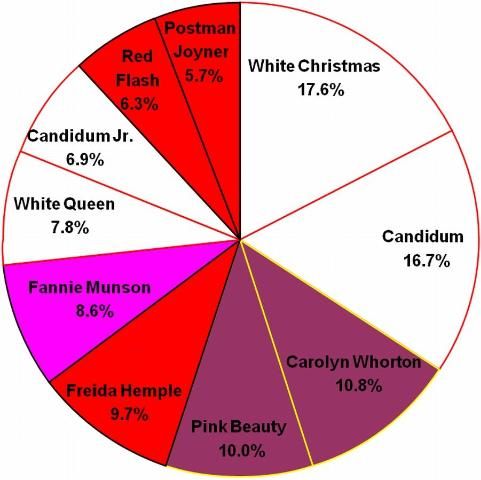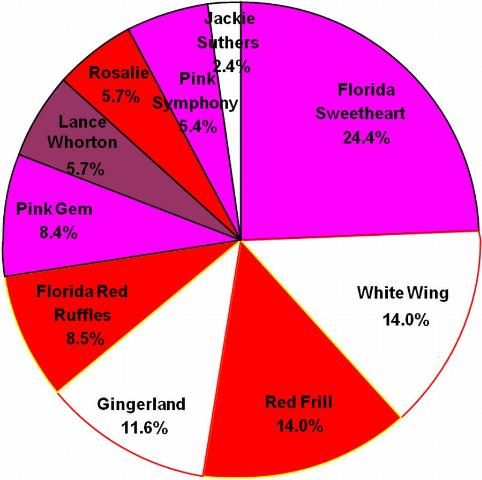Caladiums are popular tropical plants because of their bright, colorful leaves and tolerance to both heat and shade. Potted and landscape caladium plants are grown from tubers (often called bulbs). Most of the caladium tubers used throughout the world are produced by caladium growers in Lake Placid and Sebring, Highlands County, Florida. These caladium growers and their tuber-production industry are an important component of Florida's environmental horticulture industry. Additionally, these growers have a worldwide impact in the global caladium market, routinely supplying more than 95 percent of all caladium tubers worldwide.
A survey of the Florida caladium growers and industry was conducted from June to August 2003. Objectives of the survey were 1) to gather basic demographic information about the Florida caladium tuber production industry, 2) to understand the industry's needs for new cultivars, research and informational resources, and 3) to determine caladium cultivars that are currently grown commercially and to identify the leading cultivars. Similar surveys were conducted in 1979 and 1997.
In June 2003, survey forms were mailed to 20 business operations, of which 14 were at that time growing caladiums for tuber production. A total of 13 growers returned their surveys. The responses represented at least 95 percent of the total acreage in caladium-tuber production in the 2002–2003 season.
Industry-Wide General Information
Respondents reported 1,258 acres in caladium-tuber production in 2002 and 1,330 acres in caladium-tuber production 2003. These acreages are close to the 1,311 acres reported in the 1997 survey. The average number of years the respondents reported being in business was 23. Growers also reported employing an average of seven full-time employees plus 11 seasonal, part-time workers. All the responding growers reported using multiple marketing channels.
Industry Perceptions of the Need for Improved Caladium Cultivars
From 1988–2002, 13 new cultivars were released from the UF/IFAS's caladium breeding program at the UF/IFAS Gulf Coast Research and Education Center. These new cultivars were grown on more than 130 acres in the 2002–2003 season. The industry indicated need of new cultivars with improved resistance or tolerance to major diseases, especially Fusarium tuber rot and Pythium root rot, and root-knot nematodes. In addition, improved tuber yield and quality were considered as priority breeding objectives.
Industry Perceptions of Needs in Other Research Areas
Several areas have been identified as research needs. These areas include: 1) fertilization recommendation as related to fertilizer analysis, rate, frequency and timing of application; 2) disease management for grassy tubers and leaf blight; 3) new herbicides for weed control in production fields; 4) tuber curing, storage, and postharvest physiology; and 5) application of plant-growth regulators to replace the costly, manual de-eyeing process.
Industry Perceptions of Needs for Information on the Internet
The majority of respondent growers expressed their interest in being listed on the Web pages in the website developed at the Gulf Coast Research and Education Center. The growers encouraged researchers to use the Internet and websites to deliver to brokers, greenhouse growers, wholesale customers, homeowners, and other end users information related to tuber quality, container forcing, greenhouse production of pot plants, and correct landscape use. Promoting the use of caladiums in the landscape is viewed as a high priority.
Caladium Cultivars Grown in Florida
A total of 108 distinct cultivars were listed in the survey form. Respondent growers identified 92 cultivars being grown in Florida in the 2002-2003 season (Table 1). Seventy-five of the cultivars they reported growing in the 2002–2003 season were fancy-leaved, and 17 were lance-leaved. The majority of growers each grew 20-30 cultivars that season while 35 of the 92 cultivars were exclusively grown by a single grower that season.
The survey results indicated that more than 99 percent of the acreage utilized by the industry that growing season was used to produce 53 cultivars. The top 10 fancy-leaved cultivars grown that season were as follows: 'White Christmas' (17.6% of the total fancy acreage), 'Candidum' (16.7%), 'Carolyn Whorton' (10.8%), 'Pink Beauty' (10.0%), 'Freida Hemple' (9.7%), 'Fannie Munson' (8.6%), 'White Queen' (7.8%), 'Candidum Jr.' (6.9%), 'Red Flash' (6.3%), and 'Postman Joyner' (5.7%) (Figure 1). The top 10 lance-leaved cultivars grown that season were 'Florida Sweetheart' (24.4% of the total lance acreage), 'White Wing' (14.0%), 'Gingerland' (11.6%), 'Red Frill' (14.0%), 'Florida Red Ruffles' (8.5%), 'Pink Gem' (8.4%), 'Lance Whorton' (5.7%), 'Rosalie' (5.7%), 'Pink Symphony' (6.4%), and 'Jackie Suthers' (2.4%) (Figure 2).

Credit: Zhanao Deng, UF/IFAS

Credit: Zhanao Deng, UF/IFAS
Literature Cited
Bell M.L., G.J. Wilfret, and D.A. DeVoll. 1998. "Survey of caladium tuber producers for acreage of cultivars grown." Proceedings of the Florida State Horticultural Society 111:32–34.
Wilfret, G.J. and G.T. Hurner Jr. 1982. "A survey of caladium cultivars grown in Florida and their characteristics as potted plants." Proceedings of the Florida State Horticultural Society 95:190–194.


